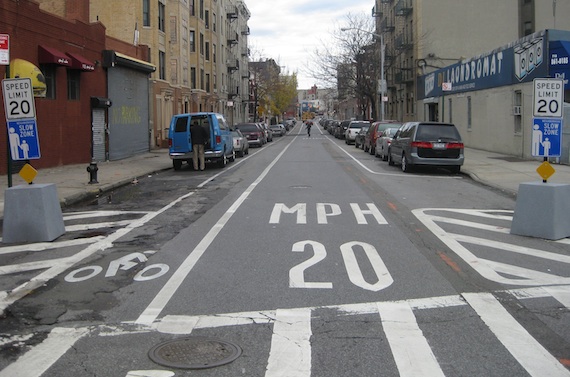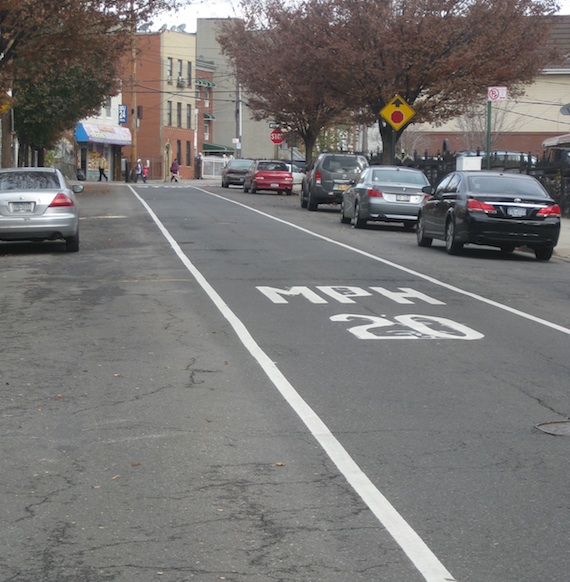
The city's first "neighborhood slow zone" officially opened this morning, bringing a 20 mph speed limit and new traffic calming treatments to the residential Claremont neighborhood in the Bronx. Transportation Commissioner Janette Sadik-Khan, joined by Bronx Borough President Ruben Diaz, Jr., City Council Transportation Committee Chair James Vacca and local District Manager John Dudley, announced that the 20 mph zones would soon be coming to neighborhoods across the city. Starting today, residents and community boards can apply for their own slow zone.
The new Claremont zone covers the roughly 35 city blocks bounded by 167th Street, 174th Street, Southern Boulevard and West Farms Road/Boone Avenue. At each entrance to the zone, street signs flank the road announcing the 20 mph limit and that it is a residential area. Inside the zone, stencils and street signs continue to trumpet the lower speed limit. Nine new speed humps have been added to five already in place, which Sadik-Khan said makes the zone largely self-enforcing. In London, slow-speed zones incorporating traffic-calming treatments are preventing dozens of deaths and serious injuries each year.

"To some people, this neighborhood is nothing more than a shortcut," said Sadik-Khan. That attitude, she noted, has had deadly results. In the last five years, 46 people were killed or seriously injured in traffic crashes in the larger community district between 2006 and 2010. The slower speeds would restore the streets to the community, she said. "Our streets are for New Yorkers. They're where we live, where we play, where we shop."
"The slow zone is now one where pedestrians will feel safe," said Diaz, who said he'd been hearing complaints about safety in the area since he served in the state Assembly. Diaz touted the fact that the program would be expanding to other neighborhoods. "This is not going to stop at Claremont," he said.
Vacca, too, celebrated the safety improvements. "They will save lives," he declared. In addition to the speed bumps slowing down cars, he urged motorists to respect the speed limit voluntarily. "Look at your speedometers and see how fast you're already going, and then slow down," he said.
The form to get your own neighborhood slow zone is already live on DOT's website, where the agency lays out the characteristics that will lead to successful applications. DOT is looking for zones that include schools, daycare centers, senior centers, and mostly residential uses, taking up an area roughly five blocks by five blocks and set off by clear boundaries, such as parks or major roads. The city wants to keep the slow zones separate from commercial areas, bus and truck routes and hospitals and fire stations.
Applications must come from community boards, business improvement districts, civic associations or elected officials, and are due by February 3. The first round of slow zones will be selected in March, according to DOT, and installed over the course of next year.
More photos of the slow zone below:







